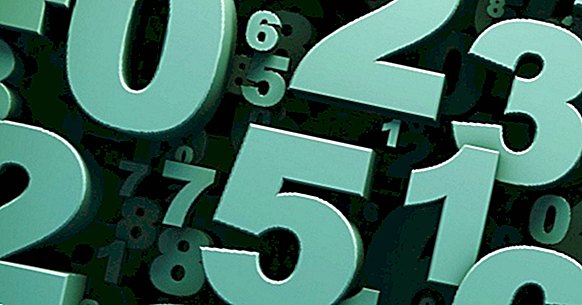Numerological obsessions: thinking about numbers constantly
Count to one hundred each time I write a word. Always turn the apple three times before you can enter the house. Touch or ask the same thing seven times in a row.
Brush your teeth exactly 35 times before spitting and clearing your mouth. All these situations have something in common: for some reason an action is carried out a certain number of times. It is common for people with numerological obsessions a, a type of obsessions typical of subjects with obsessive-compulsive disorder.
Obsessive-compulsive disorder
To understand the functioning of numerological obsessions, it is first necessary to make a brief synthesis of the disorder in which it appears: obsessive-compulsive disorder.
The Obsessive-compulsive disorder or OCD is a psychological disorder closely linked to anxiety and characterized by the presence of obsessions, intrusive and recurrent thoughts that escape the control of the person and cause a high level of anxiety, although they are recognized as their own and that they try to neutralize.
Generally, in order to reduce anxiety, the subject ends up starting to perform some kind of physical or mental action, an activity that relieves anxiety and is reinforced and repeated every time thought re-emerges, establishing itself as a compulsion. This creates a continuous spiral between obsessive thinking and anxiety-regulating mechanism, which occupies a large part of the patient's time and plunges him into a state of permanent anxiety from which he can only temporarily escape through compulsions (an escape that in turn reinforces anxiety), producing a continuous discomfort.
Entering a thought loop
The process that follows this disorder is usually the following: In a fortuitous way, one day a thought appears that the person finds aberrant and unacceptable . The fact that this idea has crossed his mind generates a high level of discomfort and anxiety, trying at all costs to eliminate the thought and avoid it as much as possible. However, the fact of trying to avoid it causes a fixation in it, making it even more likely to reappear and generating an even greater anxiety that will be avoided with greater zeal. For this he generally employs the aforementioned compulsions, which produce temporary relief from discomfort.
It is a disorder that causes the sufferer a deep suffering vital: The person knows that the thoughts and actions carried out have no logical or practical sense and lives as something absurd, but nevertheless has to take them to out to reduce your anxiety level. The same goes for obsessive thoughts.
The continuous cycle between obsession and compulsion does nothing but feed back and aggravate the state of the subject , occupying a large part of his daily time and being an element that greatly inhibits his life in various aspects. It is also not unusual for variations to appear within the vicious circle, and new anxiety-generating thoughts can be added.
The causes of the appearance of the obsessive thoughts and the fixation in them are due to multiple causes, having a certain genetic predisposition in this regard. It has been found that many of these patients have a frontal hyperactivity together with problems in the basal ganglia. It is also frequent that they appear in people strongly inhibited at a vital level, restricted in one or several aspects of their person by the society or education received.
There is a wide variety of obsessions and compulsions that people with obsessive-compulsive disorder, such as cleaning or checking. One of them is the obsessions that have to do with numbers, or numerological obsession .
Numerological obsession: numbers that settle in the mind
Count to ten. That's something that a large majority of the population has ever done, usually to calm down after something or someone has caused our anger, anger or anxiety. And is that counting and ordering makes us occupy our mind in something concrete and that demands our attention, being able to be an escape route to avoid doing something that we regret or leave aside something that alters us.
Returning to obsessive-compulsive disorder, in people who have numerological obsessions the mechanism used as a reassuring ritual of anxiety is based precisely on this. But then, Why do we speak of numerological obsession and not of numerological rituals or compulsions?
A mechanism to calm anxiety ... or anxiety itself
This is because people with numerological obsessions do not only use numbers as a mechanism to calm anxiety, but in them the numbers themselves are the reason for anxiety.This type of cases is of great complexity, since in them the person would be totally blocked, to the point of having forgotten the reason that led him to use numbers as a way of reassuring and transforming what was compulsion into obsession. This does not mean that the original idea has vanished but that it has masked the subject that produces obsession.
The way in which the numbers are applied is very varied. There are people who have to count mentally up to a certain number, perform an action determined number of occasions, have a specific amount of objects or avoid contact with anything linked to one or several numbers in question. In fact it can appear related to other obsessions and compulsions such as cleaning, but in the case of numerological obsession what will prevail is the number and not the action per se (that is, if they do not wash X number of times, their anxiety it does not decrease).
There are numerous cases of OCD with numerological obsessions , being frequent the obsession with concrete numbers or with groups of them that have common characteristics (for example with the odd or even numbers). A well-known example is the famous inventor Nicholas Tesla, who was obsessed with number three in multiple aspects of his life.
Treating the numerological TOC
The treatment of obsessive-compulsive disorder has been somewhat complex throughout history, being a disorder traditionally difficult to treat. Thus, OCD (including numerological obsessions).
One of them is from pharmacology, which allows treating and reducing the symptoms with a certain level of effectiveness. Especially effective are the antidepressants that inhibit the reuptake of serotonin, the SSRIs.
Generally, from the cognitive-behavioral side, obsessive-compulsive disorder is treated through exposure techniques with prevention of response, causing the patient to gradually dissociate obsessive thinking and compulsion. Since the repetition of the compulsion maintains by negative reinforcement the vicious circle of the obsession-compulsion, it is one of the most applied therapies to treat the symptomatology.
In the case of the numerological obsession, this type of treatment encounters the problem that it is more complicated to find the origin thought that causes the anxiety and to work with it . In spite of this, working on the prevention of response is possible and can facilitate the reduction of overt behaviors.
Alongside this, interventions are applied to make the level of responsibility of the patient realistically see the facts that imagine the non-fulfillment of the rituals may occur, make visible that trying to deny a thought causes us to relapse in it and to think something negative It does not imply doing it. Again, in the numerological obsession this type of treatment is of great complication since it is not visible what concrete thought produces the problem. It is necessary a deep analysis of the case and the circumstances that surround it to discover it
Other therapies of currents such as psychodynamics show that although the treatment of the symptom is very useful to improve the patient's condition and can lead to success, the treatment should focus on modifying the primary cause that caused the patient's obsessive structure . In this aspect reducing inhibition and uncovering and directing the internal energy to what the individual really desires can greatly help to cause a structural change in the person, which can contribute greatly to the recovery of the person.
Bibliographic references:
- American Psychiatric Association. (2013). Diagnostic and Statistical Manual of Mental Disorders. Fifth edition. DSM-V. Masson, Barcelona.
- Pickover, C.A. (2002). The wonder of numbers, Ma Non Troppo.
- Ruiz, D. (2014). Release the monkey, rescue the princess. The AFOP method to free yourself from obsessions. RIOCC Editorial: Barcelona.
- Santos, J.L. ; García, L.I. ; Calderón, M.A. ; Sanz, L.J .; de los Ríos, P .; Left, S .; Román, P .; Hernangómez, L .; Navas, E .; Thief, A and Álvarez-Cienfuegos, L. (2012).
- Clinical psychology. CEDE Preparation Manual PIR, 02. CEDE. Madrid.
- Vallejo, J. & Leal, C. (2010). Treaty of Psychiatry. Volume II. Ars Medical. Barcelona.



















